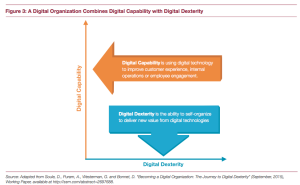The report by Capgemini, “Organizing for Digital: Why Digital Dexterity Matters” — conducted in collaboration with MIT Center for Digital Business — reveals that digital organizations reported outperforming competitors on key performance indicators, such as customer satisfaction and innovation. The ‘digital masters’, just 7% per cent of companies, display “digital dexterity” – the ability to rapidly change organizational design to realize more value from digital technologies – such as forging new partnerships or identifying and deploying internal expertise.
MY POV: This makes sense as most companies are still trying to decide if they should or need to pay attention to digital — like it’s a channel or a app. It’s really a mindset of how a business is run and how decisions are made and whether or not departments understand their individual contribution to the customer experience as it fits into the overall, brand customer experience. Individual departments can no longer remain silos. They must do their part in the context of the whole. Otherwise the customer experience, as some point in the value chain ends up not meeting or exceeding customer expectations. And not meeting customer expectations means customers will no longer be customers. They will patronize competitors who have maximized their digital dexterity because the customer experience will be more optimized to be customer-centric.
Digital Dexterity Self-Assessment: Based on the research results, the report provides a high-level self assessment guide allowing executives to gauge where their organizations are on the digital dexterity continuum. It also reveals that advanced levels of digital dexterity allows organizations to seize opportunities and respond to disruptions much more quickly than their traditional competitors. In today’s volatile and disrupted world, capability leadership is not enough. Organizations also need to be nimble and flexible – dexterous – if they are to respond to ever-changing technology advances, emerging competitive disruptions, and changing customer needs

Digital Capabilities Drive Business Results: Digital capabilities drive business results in key areas such as improving the customer experience, boosting employee engagement or enhancing internal operations. However, digital dexterity allows organizations to seize opportunities – and respond to disruptions and changes – much more quickly than their traditional competitors. Our research found that organizations that are high on digital dexterity are more responsive, better at finding talent, and able to self-organize at speed. They also enjoy significant advantages in identifying and re-deploying expertise when it is needed and are better at establishing partnerships (see figure below.)
Every enterprise has the potential to become a digital organization, but it will require leadership, investment and tenacity. Drawing on our research, our experience in working with clients and interviews with industry practitioners, we have identified four dimensions that are critical (see figure below).
- Digital-First Mindset: seeking and prioritizing digital solutions first and foremost
- Digitized Practices: digitizing operations and encouraging collaborative ways of working and learning
- Empowered Talent: raising the digital IQ of the organization, developing key skills and increasing engagement
- Data Access & Collaboration Tools: accessing data and collaboration tools to drive innovation and share intelligence across the organization
A Digital Mindset: A digital-first mindset is a distinguishing feature of a digital organization. It means that the default position of the organization is to employ a digital solution first. For instance, how does the organization connect with its customers? How does it redesign its core processes using the power of digital technologies? How does the organization think of addressing any new challenge using digital technologies rather than traditional approaches? In the research, 80% of digital organizations said that they take advantage of digital solutions wherever possible, as against only 37% of all firms.
Digitized Practices: Digitized operations, data-driven decision- making and collaborative learning are essential practices for organizations’ adaptability and long-term resilience. In our survey, 80% of digital organizations believed that their core operational processes were automated and digitized. Across all firms this drops to 32%.
Empowered Talent: In the survey, 70% of digital organizations said that their enterprises have well- established, well-distributed digital skills. However, across all firms, this drops to just 14%. Digital organizations put a premium on building widespread digital skills and ensuring engagement for its people within and beyond their organization’s boundaries.
Is your organization stalling, intimating, engaging or self-reinforcing digital capabilities? To find out more, here’s the whole report.
@drnatalie, VP and Principal Analyst, Constellation Research
Covering Customer-Facing, Digitized Organizations
This report comes after two years of research that was conducted in collaboration with MIT’s Center for Digital Business from January 2014 to September 2015. Together, the team conducted in-depth interviews with thirty-one industry leaders representing enterprises from a range of industries to assess the qualities of companies that were able to quickly adapt to the increasing use of digital technologies and data. A survey of 274 industry executives, representing 138 different enterprises across 28 countries was then conducted to validate the relationship of an organization’s key characteristics with abilities that help firms easily adapt to new technologies.




